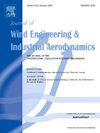Mechanism of vortex-induced vibration in two lock-in regions for truss girder sections
IF 4.9
2区 工程技术
Q1 ENGINEERING, CIVIL
Journal of Wind Engineering and Industrial Aerodynamics
Pub Date : 2024-11-08
DOI:10.1016/j.jweia.2024.105946
引用次数: 0
Abstract
The long-span bridge has a flexible structure and low damping. And the truss girder section is relatively blunt, which is prone to vortex-induced vibration(VIV). Initially, the wind tunnel tests are carried out at two scales to test the two lock-in regions of VIV for the truss girder. Then, the fluid-structure coupling analysis numerical model of the simplified two-dimensional(2-D) section of the truss girder is established, and the analysis results are compared with the experiment. Finally, the time-frequency characteristics of the aerodynamic lift and the wind speed at the movable monitoring points, further the meso-mechanism of the vortex evolution in two lock-in regions are analyzed. The results indicate that there are both twice key changes in the lift frequency components during the whole process of VIV in the two lock-in regions with the increase in amplitude, which are related to the change in flow pattern. VIV in the first lock-in region is self-excited by the coupling of the wake vortex of the bridge deck and the motion of the model. VIV in the second lock-in of VIV is self-excited by the impinging shear layer instability at the leading edge of the bridge deck and the motion of the model.
桁架梁截面在两个锁定区的涡流诱导振动机理
大跨度桥梁结构灵活,阻尼小。而桁架梁截面相对较钝,容易产生涡激振动(VIV)。首先,在两个尺度上进行风洞试验,以测试桁架梁 VIV 的两个锁定区域。然后,建立了桁架梁简化二维截面的流固耦合分析数值模型,并将分析结果与试验结果进行了对比。最后,分析了可移动监测点的气动升力和风速的时频特性,并进一步分析了两个锁定区域内涡流演变的中观机制。结果表明,在两个锁定区域 VIV 的整个过程中,升力频率分量均有两次关键变化,且振幅增大,这与流型的变化有关。第一个锁定区域的 VIV 是桥面尾流涡旋与模型运动耦合作用下的自激。VIV 第二锁定区的 VIV 是由桥面前缘的冲击剪切层不稳定性和模型运动自激产生的。
本文章由计算机程序翻译,如有差异,请以英文原文为准。
求助全文
约1分钟内获得全文
求助全文
来源期刊
CiteScore
8.90
自引率
22.90%
发文量
306
审稿时长
4.4 months
期刊介绍:
The objective of the journal is to provide a means for the publication and interchange of information, on an international basis, on all those aspects of wind engineering that are included in the activities of the International Association for Wind Engineering http://www.iawe.org/. These are: social and economic impact of wind effects; wind characteristics and structure, local wind environments, wind loads and structural response, diffusion, pollutant dispersion and matter transport, wind effects on building heat loss and ventilation, wind effects on transport systems, aerodynamic aspects of wind energy generation, and codification of wind effects.
Papers on these subjects describing full-scale measurements, wind-tunnel simulation studies, computational or theoretical methods are published, as well as papers dealing with the development of techniques and apparatus for wind engineering experiments.

 求助内容:
求助内容: 应助结果提醒方式:
应助结果提醒方式:


